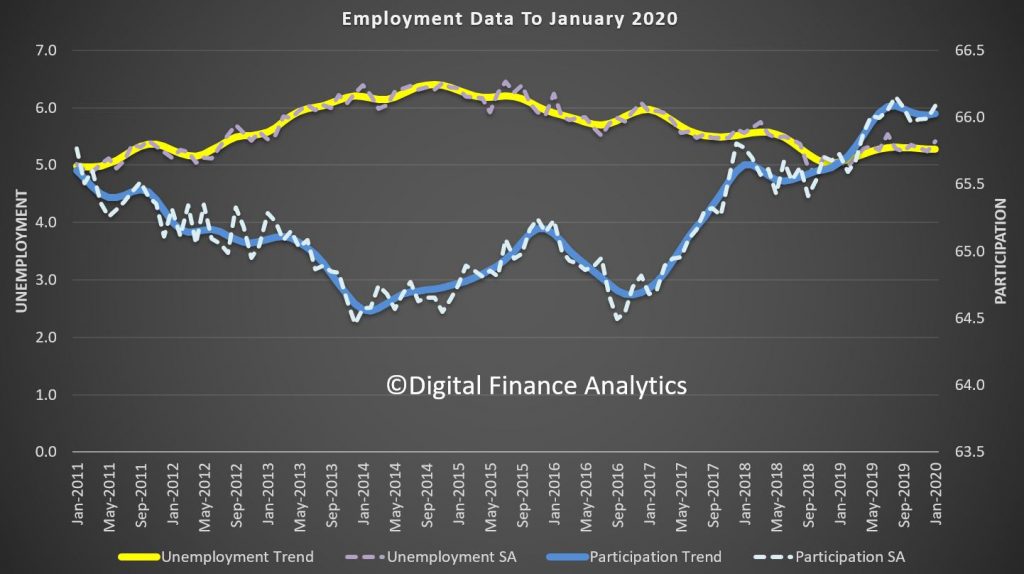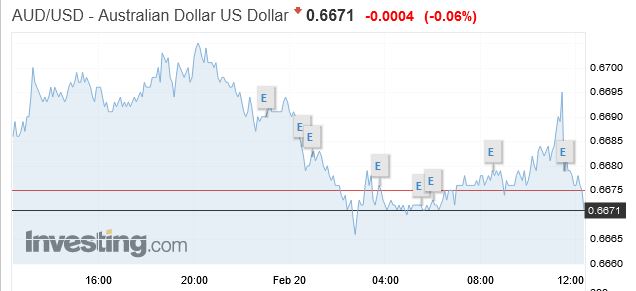Interesting test today, as according to the latest ABS figures on unemployment trend stayed at 5.2%, but seasonally adjusted rose 0.2% to 5.3%. Who will report what (many were keen to highlight the recent falls in SA terms, will the reverse be true too?). We continue to prefer the more reliable trend series. Note too the incoming rotation group had a higher unemployment rate than the group it replaced. So, how much is real and how much noise? Still whatever, on these numbers you can forget wages growth. And this is before the China freeze really hit!

Employment and hours
In January 2020, trend monthly employment increased by around 20,000
people. Full-time employment increased by around 15,000 and part-time
employment increased by around 5,000 people.
Over the past year, trend employment increased by around 257,000 people
(2.0 per cent), in line with the average annual growth over the past 20
years (2.0 per cent).
Year on Year Employment Change Over 20 Years (%)
Full-time employment growth (1.7 per cent) was above the average annual growth over the past 20 years (1.6 per cent) and part-time employment growth (2.8 per cent) was below the average annual growth over the past 20 years (3.0 per cent).
The trend monthly hours worked increased by less than 0.1 per cent in January 2020 and by 1.3 per cent over the past year. This was lower than the 20 year average annual growth of 1.6 per cent.
Underemployment and underutilisation
The trend monthly underemployment rate remained steady at 8.5 per cent in January 2020, and increased by 0.2 percentage points over the past year.
“The underemployment rate continues to remain high, but is still below the levels from 2016-17,” said Mr Hockman.
The trend monthly underutilisation rate also remained steady at 13.7 per cent in January 2020, an increase of 0.4 percentage points over the past year.
States and territories trend unemployment rate
The monthly trend unemployment rate increased in Victoria and decreased in South Australia and Tasmania in January 2020. The unemployment rate remained steady in all other states and territories.
Over the year, unemployment rates fell in Western Australia, Tasmania and the Australian Capital Territory. Unemployment rates increased in New South Wales, Victoria, Queensland, and the Northern Territory.
Seasonally adjusted data
The seasonally adjusted unemployment rate increased by 0.2 percentage points to 5.3 per cent in January 2020, while the underemployment rate increased 0.3 percentage points to 8.6 per cent. The seasonally adjusted participation rate increased by 0.1 percentage points to 66.1 per cent, and the number of people employed increased by around 14,000.
The net movement of employed in both trend and seasonally adjusted terms is generally underpinned by over 300,000 people leaving employment and around 300,000 people entering employment in the month.
In original terms, the incoming rotation group in January 2020 had a lower employment to population ratio than the group it replaced (62.0% in January 2020, compared to 64.2% in December 2019), and was higher than the sample as a whole (61.8%). The incoming rotation group had a lower full-time employment to population ratio than the group it replaced (43.2% in January 2020, compared to 44.5% in December 2019), and was higher than the sample as a whole (42.7%).
The incoming rotation group had a higher unemployment rate than the group it replaced (5.8% in January 2020, compared to 4.0% in December 2019), and was higher than the sample as a whole (5.7%). The incoming rotation group had a lower participation rate than the group it replaced (65.8% in January 2020, compared to 66.9% in December 2019), and was higher than the sample as a whole (65.6%).
Aussie continues to drift lower after the news….

